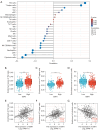Exploring SSR1 as a novel diagnostic and prognostic biomarker in hepatocellular carcinoma, and its relationship with immune infiltration
- PMID: 39525035
- PMCID: PMC11543030
- DOI: 10.21037/tcr-24-277
Exploring SSR1 as a novel diagnostic and prognostic biomarker in hepatocellular carcinoma, and its relationship with immune infiltration
Abstract
Background: Although signal sequence receptor subunit 1 (SSR1) has undergone thorough examination in different cancer types, its importance in hepatocellular carcinoma (HCC) remains largely uncharted and warrants further investigation. The aim of this study is to explore the role of SSR1 in HCC progression and to decipher its underlying molecular mechanisms.
Methods: We employed the ONCOMINE, Tumor IMmune Estimation Resource (TIMER), and The Cancer Genome Atlas databases to assess SSR1 expression levels within tumor tissues. Logistic and Cox regression analyses, Kaplan-Meier survival plots, nomograms, and forest plots were employed to establish correlation between SSR1 and prognosis. Receiver operating characteristic (ROC) curves demonstrated diagnostic utility of SSR1. Additionally, Gene Ontology (GO) and gene set enrichment analysis (GSEA) analyses were conducted to uncover relevant molecular pathways. TIMER was instrumental in elucidating the connection between SSR1 and immune cell infiltration. Actions of SSR1 in HCC proliferation and migration were investigated through quantitative real-time polymerase chain reaction, Cell Counting Kit-8, 5-ethynyl-2'-deoxyuridine cell proliferation assays, and Transwell migration and wound healing experiments.
Results: Elevated SSR1 levels were found to be correlated with clinical parameters such as age and pathologic stage, thereby predicting a reduced overall survival (OS) rate in HCC patients. Multivariate survival analysis underscored SSR1 as an independent prognostic marker for OS. A nomogram underscored SSR1's effectiveness as a predictive tool for HCC outcomes, while ROC analysis indicated its high diagnostic accuracy. GO and GSEA analyses suggested that elevated SSR1 expression may be associated with epithelial-mesenchymal transition (EMT) pathway. SSR1 exhibited a negative correlation with cytotoxic cells and a positive correlation with Th2 cells. Our in vitro experiments provided evidence that heightened SSR1 levels may impact HCC proliferation and migration through EMT pathway.
Conclusions: SSR1 surfaces as a new diagnostic and potentially prognostic biomarker, showing an association with immune cell infiltration and cell proliferation in HCC.
Keywords: Signal sequence receptor subunit 1 (SSR1); epithelial-mesenchymal transition (EMT); hepatocellular carcinoma (HCC); immune infiltration.
2024 AME Publishing Company. All rights reserved.
Conflict of interest statement
Conflicts of Interest: All authors have completed the ICMJE uniform disclosure form (available at https://tcr.amegroups.com/article/view/10.21037/tcr-24-277/coif). The authors have no conflicts of interest to declare.
Figures








Similar articles
-
Clinical Value for Diagnosis and Prognosis of Signal Sequence Receptor 1 (SSR1) and Its Potential Mechanism in Hepatocellular Carcinoma: A Comprehensive Study Based on High-Throughput Data Analysis.Int J Gen Med. 2021 Oct 30;14:7435-7451. doi: 10.2147/IJGM.S336725. eCollection 2021. Int J Gen Med. 2021. PMID: 34744454 Free PMC article.
-
Comprehensive exploration of signal sequence receptor subunit 1 (SSR1) as a diagnostic and prognostic biomarker in liver hepatocellular carcinoma.Am J Transl Res. 2025 Jan 15;17(1):560-584. doi: 10.62347/ANXV3598. eCollection 2025. Am J Transl Res. 2025. PMID: 39959210 Free PMC article.
-
UBR1 is a prognostic biomarker and therapeutic target associated with immune cell infiltration in gastric cancer.Aging (Albany NY). 2024 Aug 23;16(16):12029-12049. doi: 10.18632/aging.206079. Epub 2024 Aug 23. Aging (Albany NY). 2024. PMID: 39181686 Free PMC article.
-
AUNIP Expression Is Correlated With Immune Infiltration and Is a Candidate Diagnostic and Prognostic Biomarker for Hepatocellular Carcinoma and Lung Adenocarcinoma.Front Oncol. 2020 Dec 9;10:590006. doi: 10.3389/fonc.2020.590006. eCollection 2020. Front Oncol. 2020. PMID: 33363020 Free PMC article.
-
A novel prognostic models for identifying the risk of hepatocellular carcinoma based on epithelial-mesenchymal transition-associated genes.Bioengineered. 2020 Dec;11(1):1034-1046. doi: 10.1080/21655979.2020.1822715. Bioengineered. 2020. PMID: 32951492 Free PMC article.
References
LinkOut - more resources
Full Text Sources
Miscellaneous
